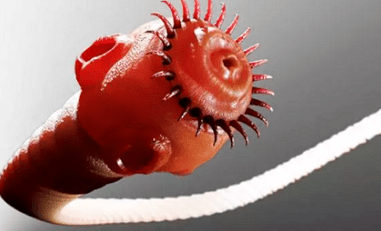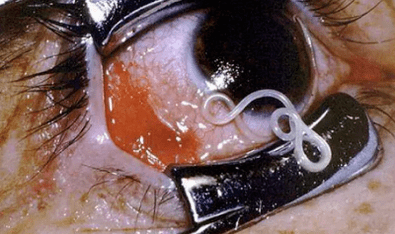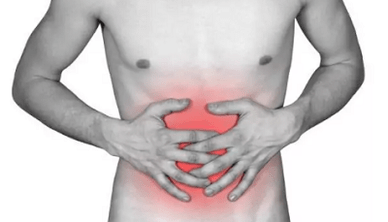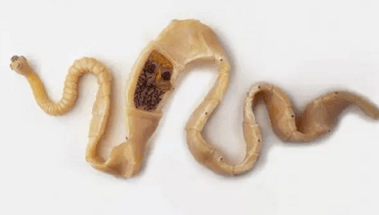Every modern person encounters the problem of intra-parasites at least once in his life.Literally, the number and diversity of parasites that cannot survive without us is simply enormous.Parasites in the human body use it as a source of food and habitat until they completely deplete it but do not emit it.
Parasites are microscopic in size, or can grow up to several meters, but even in this case, their important activity in the body is not always felt.Usually, a person does not feel them, nor even knows their existence in his body.At the same time, they are able to live in the human body for years or even decades, causing irreparable harm.
Parasites in the human body pose serious dangers and pose a huge threat to human health because they violate the work of internal organs and systems, cause failure of the immune system's work, and interfere with the complete assimilation of useful substances, vitamins and minerals.In some cases, the situation is so severe that it can even lead to death.
Types of relationships between organisms
In nature, there are several types of relationships between organisms that influence each other.
The effect of one species on another may be neutral or positive and negative.
In addition, this relationship has different combinations.distinguish:
- Symbiosis;
- neutralism;
- antibiotic.
Symbiosis is a form of relationship between two organisms, both of which benefit.
Neutralism is a biological connection that involves two organisms living in one field, but at the same time, they have no relationship with each other and do not directly affect each other.
Antibodies are an antagonistic type of biological relationships in which one population limits the possibility of another population, thus adversely affecting it.One of the most negative types of antibodies is parasites.
Parasites and parasites

Parasites are an antibiotic form where one species represents the body of another species as a temporary or constant source of environmental environment and nutrition.
Biological organisms at the expense of another organism are called parasites.
Parasites do not kill their owners, but use them for a long time as a source of food and habitat.
Parasites include:
- Parasitic worms;
- Pathogenic bacteria;
- Protozoa;
- mushroom;
- Virus.
The host organism can be:
- bacteria;
- Protozoa;
- plant;
- animal;
- Human.
During development, parasites pass through several developmental stages from eggs and larvae to adults (sexual maturation, invasive), which suggests that they live a long life span and require 2-3 owners to be changed.
Classification of parasites
All parasites are divided into keys and optional.
The intrahost parasites are outside of death or inactive.For example: virus.They lead the parasitic lifestyle alone, that is, they are entirely dependent on the owner and activate their activities.
Optional parasites have a parasitic lifestyle, but can exist in an absolutely normal form in the external environment if necessary.For example: pathogenic mushrooms and bacteria.
According to the nature of the relationship with the subject, they shared:
- The real parasite;
- Fake parasites;
- Super parasite.
The real parasite is the same bonded parasite in which the parasitic lifestyle is the only form of survival.However, there are some parasites that can be bonded (constant) and optional (time).For example: lice, flea, intestinal rudder.
Fake Parasite - A voluntary creature that, if accidentally enters the body, can live in it for a while and harm it.For example: The larvae in the room fly in a person's intestines.
Super parasites are parasites that live among other parasites.For example: bacteria and viruses that live in other parasites that live in other organisms.

According to the duration of interaction with the host body, they distinguish:
- constant parasite;
- Temporary parasite.
Continuous parasites are organisms that perform the entire life cycle in the body - owners, placing the larvae in it.For example: ass worm, tap worm, lice.
Temporary parasite; live and eat at the expense of the owner at a certain stage of development.For example: voltflies and larvae imaging (adult insects) in fleas and mosquitoes.
At the main position, parasites are divided into:
- Epiparasite;
- Endoparasitic.
Epiparasitics are creatures that live on the skin of the host's body.For example: lice, flea, tick.
Endoparasitics are organisms located in the host body.Endoparasitics are divided into:
- Internal parasites;
- tissue parasites;
- Intracellular.
Capturing endoparasi are organisms located in cavity connected to the external environment, such as: Ascaris, Vlasov, headed by the human intestine.
Fabric Parasite - A type of biological located in the enclosed cavity and tissues within the host, such as: liver bacon, cysts of tape.
Intracellular parasites are located in human cells - for example: Malaria parasite, Toxoplasma gondii.
In terms of environmental distribution, parasites are:
- Curly, encounter everywhere.
- Tropical, very common in tropical climates only.
According to biological and epidemiological characteristics, parasites are divided into:
- Geographical location- These are parasites that initially undergo developmental stages in the human body and then in an external environment (e.g., the Earth);
- Biogelminters- Parasites that occur not only in the human body, but also in other organisms.Usually, one is the end owner, sometimes the middleman.
- Contact HelminthsThey are different from the host's body and are therefore mature or half mature, so it is possible to repeat their infection or infection (self-disorder, Reinvasia) in another person.
How parasites fall into human body
There are many favorable factors that cause parasites to enter the human body:

- Dirty hands;
- animal hair;
- Cooked products (digestive factors);
- Contact family factors;
- Can be spreadable;
- veteran.
Dirty hands are the main source of infection for parasitic diseases.There are many diseases called "dirty hand disease".The larvae of the worm first fall on the skin of the hand and then cause characteristic symptoms of the gastrointestinal tract in the mouth.The transmission paths of these infections are called feces.Therefore, the worms that come into contact with worms fall into our bodies.For example, Akkad eggs enter the human body through dirty hands, fruits, fruits, berries, greens and are spread to the flies.
Animals and their wool are the sources of ascaride and liphyli with worms.For example, it has been falling out of the animal's wool for a long time, staying alive (up to 6 months) and falling on carpets, stuff, bedding, children's toys and hands, penetrating the food area.
Similarly, through wet breathing, dogs and cats are able to emit parasite eggs at a distance of 3-5 meters.In addition, dogs and cats also have fleas on their wool, and they also tolerate worm eggs.
Breeding methods for parasite infection:
- By washing poor vegetables and fruits;
- Cooked food (usually usually meat);
- Infected water.
For example, cooked barbecue, argency or homemade lard can infect people with thyroiditis and echinococcus, while cooked dried fish or caviar can cause sticky problems and wide tape infection.
The transmission of infection occurs in the case of insects absorbed by blood, such as: ticks, mosquitoes, lice, fleas, insects.
Contact - A home infection path is performed through an infected person or animal when exposed to or using common household items.
The infection method occurs in a reservoir or during contact with infected soil.In contact with water or infected soil, larvae penetrate the body through the mucosa or human skin.
Functions of the device
Almost all parasites are perfect for survival.There are many factors that lead to its high vitality:
- Expectations of longevity.For example, worms have lived in the human body for many years, sometimes as much as their owners.
- For decades, worm eggs have been able to last and not collapse in the external environment.
- The development stage of the parasite also contributes to its life expectancy.Starting from the egg, in the absence of nutrition, it passes through all stages of development starting from the egg, starting from the egg, continuing the changes in the larvae and owner.
- The ability of parasites to cause an immune-deficient state in the owner, which allows you to penetrate pathogenic agents from the outside, as well as “incite” dormant internal infections.
- Worms that fall into a person's gastrointestinal tract produce anti-enzymes, which enable them to pass their own death, but at the same time, they violate the normal diet and cause toxic processes - allergic reactions in the host: asthma, urticaria, urticaria, dermatitis.
- The invincibility of parasites is related to the exchange of genetic information during sexual reproduction, which leads to the stability of their heterogeneous populations.
- In many habitats, worms have a wide range of vitality: soil, water, animals, plants.
- Since parasites can inhibit or modify the host's immune response, effective immune prevention methods are lacking.
How to identify endoparasitics

Often, a person asks a question when completely destroying his health.A person usually dismisses the issue at the initial stage until it grows into serious form and affects his well-being.
Since parasites are separated by habitats inside the body - the owner divides the parasites into endoparasitics and ectoparasitics, the symptoms are divided into internal and external.
Epiparasitics are characterized by certain activity, which manifests as the following symptoms:
- rash;
- Itching;
- combustion;
- Congestion;
- Pain (if it is biting);
- There is a wound at the bite location.
Detecting endoparasitics is much easier.To do this:
- visual recognition (if the penetration of the outside through the skin);
- Microscopy.
During evolution, the “dependents” adapt to survival during evolution while disguising themselves without betraying themselves, and they perform destructive work in the host’s body.After all, a person's life, such as worms, may take several months to decades since their development phase occurs.So how to determine the existence of in vivo parasites?
External and internal expressions
Because parasites vary in long-term life expectancy and actively reproduce in the human body, they can cause long-term recurrence and chronic symptoms.
External manifestations of parasite activity include:
- rash;
- Itching;
- combustion;
- Congestion;
- fever condition;
- Quincke's edema.
It is important to know that the extent of allergies development depends on many factors:
- The location of the parasite in the body;
- Parasites come into contact with tissues and vital organs;
- The amount of toxin produced.
The following symptoms include internal invasion:
- Diseases of gastrointestinal work (nausea, diarrhea, belching);
- Weight fluctuations are associated with nutritional deficiency and reduced appetite;
- People crave candy due to metabolic diseases and general weakening of the body;
- Chronic fatigue syndrome, caused by general fatigue, lethargy, insomnia, impaired concentration and memory in some cases;
- Constant headache caused by body weakness and poisoning;
- Tooth grinding in dreams (tooth grinding), especially in children.
- Swelling of limbs;
- Neurological and psychological illnesses, because parasites can cause depression and irritability;
- paroxysmal cough;
- Muscle and joint pain;
- The pain of skin;
- Skin lesions (dermatitis, eczema, acne and acne).
It is particularly important to understand the general symptoms observed for intestinal parasitic invasion.

Violations in the digestive tract are manifested by the following symptoms:
- intestinal spasm;
- Irritable bowel syndrome;
- Flavor;
- Constipation or diarrhea;
- Change the color of the feces;
- itching in the anus;
- visual detection of worms;
- There are worms in the gag.
Because worms can reach important dimensions in the body, they are able to physically complicate the progress of feces and violate the works of other organs, such as bile ducts.
Parasites can cause violations in the work of a specific organ or system.
The most common violations are:
- anemia.
- Central nervous system lesions.
- Abscess in the liver.
- Purulent inflammation of the gallbladder and pancreas.
- The fruits of immunity work until the development of the autoimmune response.
- Diseases in respiratory system operation.
- Joint disease.
Diagnosis of parasites
All of the above symptoms cannot always accurately confirm the presence of in vivo parasites, as this symptoms can be observed through many diseases.
When checking for feces, you can establish the presence of parasites in the human body.However, this approach is unreliable because parasite larvae cannot always see or skip them through a microscope.Also, not all parasites produce many eggs.
In order to detect parasite larvae in feces, it is necessary to perform 8-10 times of fecal analysis.However, if in this case, the analysis shows nothing, but the doctor has questions, it prescribes many serum blood tests, which will help detect antibodies to the worms that appear in the blood after a parasite infection.

There are other ways to identify "dependants" SO is called string testing.A string with the capsule is inserted through the nose into the intestine and removed after four hours along with the received sample.
Another approach is colonoscopy, in which the experts use special probes to consider the condition of the inner surface of the colon.
Experts have found that the most common parasite is worms.Furthermore, they are all very feasible and fertile, and their goal is to destroy their masters and extract the best benefits for themselves.
How to remove parasites from the human body
It's hard to get rid of parasites, but it's possible.Priority: Not only is it necessary to know how to get rid of parasites, but also to understand what the treatment process itself is.It is carried out in three directions:
- The destruction of parasites at various stages of existence.That is, it is necessary not only to destroy adults, but also to destroy larvae and their eggs.
- The work of all organs and systems of the human body is normalized.
- Recover your body.
To meet all three of the above items, plant ingredients will be formulated by experts to contribute to modern medicines.
These drugs are modern drugs and have certain therapeutic effects.The use of these drugs in the complex allows you to combine their therapeutic effects and achieve wonderful results.
Mutual dosage and drug combinations are performed according to:
- The stage of parasitic invasion;
- The general condition of the patient;
- Availability of a certain body's complications;
- Severity of the disease course.
The priority of deworming drugs is based on:
- efficiency;
- Safety;
- Combine several drugs for the possibility of optimal therapeutic effects.
The treatment of folk therapy is a very effective way to get rid of parasites.In most cases, using grass to clean tea, neutralize the harmful effects of parasites and clean the liver and gallbladder.
They prepare as follows: Take a tablespoon of the following plants: oak bark, Buckthorne, Warmwood, Tansey.Then, pour a tablespoon of the plant mixture into 500 ml of boiling water and then leave it in a closed plate overnight.In the morning, empty stomach, drunk 100 grams of drunkenness.Treatment lasts for two to three weeks.
Pumpkin seeds are also very effective in fighting parasites.To get rid of the parasites, 300 grams of pumpkin seeds were taken and they were washed, but at the same time, they left as much transparent film as possible, which wrapped around the seeds.Seeds must be eaten on an empty stomach.This recipe not only eliminates parasites, but also improves the function of the intestine, stomach, liver, and gallbladder.





















